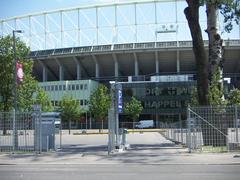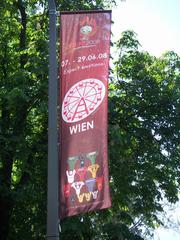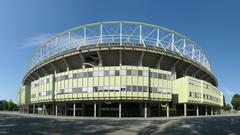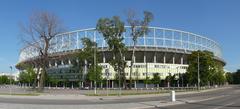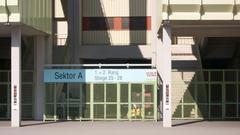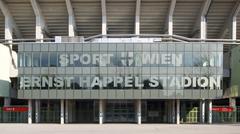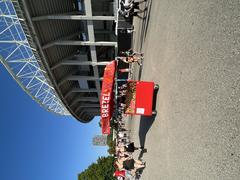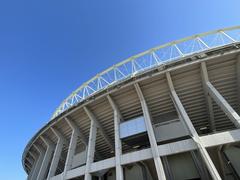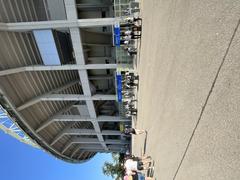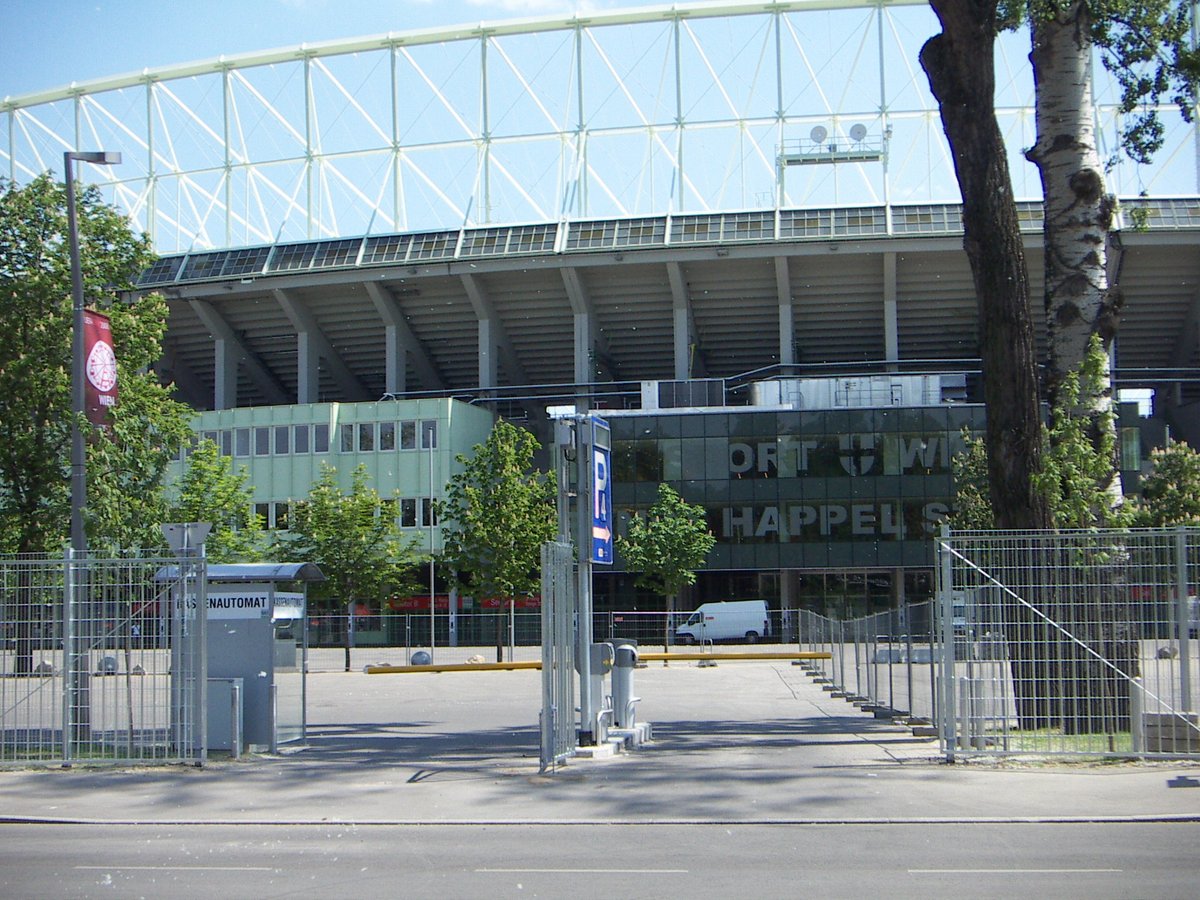
Ernst Happel Stadion Visiting Hours, Tickets, and Vienna Historical Sites Guide
Date: 14/06/2025
Introduction
Nestled in Vienna’s lively Leopoldstadt district, the Ernst-Happel-Stadion is Austria’s largest sports arena and a monument of profound historical and cultural significance. Established in 1931 as the Praterstadion and renamed in honor of legendary coach Ernst Happel in 1992, the stadium has borne witness to dramatic chapters in Austria’s history and hosted countless world-class football matches, European finals, and iconic concerts (en.wikipedia.org; mysportstourist.com). Today, it stands as a testament to Vienna’s dedication to sports, sustainability, and cultural innovation, offering immersive experiences for visitors through guided tours and major events (thestadiumbusiness.com; wienersportstaetten.at).
This guide will provide detailed insights into the stadium’s history, visitor information—including hours and ticketing—architectural highlights, transportation, accessibility, and nearby attractions to help you plan a memorable visit to one of Vienna’s most celebrated landmarks.
Table of Contents
- Introduction
- History and Architectural Evolution
- Cultural and Sporting Significance
- Sustainable Innovations
- Visitor Information
- Nearby Attractions
- Frequently Asked Questions (FAQ)
- Summary and Final Tips
- References
History and Architectural Evolution
Conception and Construction (1928–1931)
The vision for a modern, multi-functional stadium in Vienna materialized in 1928, with construction commencing under architect Otto Ernst Schweizer’s direction. The stadium was completed in just under two years and opened officially on July 11, 1931, as Praterstadion for the second Workers’ Olympiad (en.wikipedia.org). With an initial capacity of around 60,000 spectators, the design featured innovative rapid evacuation systems and included adjacent facilities like the Stadionbad, Europe’s largest outdoor swimming pool at the time (de.wikipedia.org; kids.kiddle.co).
Wartime Years and Post-War Reconstruction
From 1938 to 1945, the stadium was used as military barracks and, tragically, as a collection point for Viennese Jews before their deportation (simple.wikipedia.org). Bombing raids in 1944 caused severe damage. After the war, the venue was restored, and by 1948, it resumed its place in Vienna’s sporting life, symbolizing a return to normalcy and national pride (de.wikipedia.org).
Expansion and Modernization
A post-war expansion between 1956 and 1959 increased capacity to over 91,000, establishing the stadium as one of Europe’s largest unified-structure venues (www.stadiumguide.com). The stadium hosted significant events, including the 1964 European Nations’ Cup final and several UEFA finals. Record attendance reached 90,726 in 1960 (simple.wikipedia.org).
Modernization in the 1980s brought a covered seating area and advanced amenities. The stadium re-opened in 1986, featuring a fully seated arrangement to comply with international standards (en.wikipedia.org).
Renaming and Recent Renovations
Following the passing of Ernst Happel in 1992, the stadium was renamed to honor one of Austria’s most influential football figures. In preparation for UEFA Euro 2008, the stadium underwent extensive renovations: a new facade, heated pitch, and temporary seating expansion to 53,000 (vienna-concert.com). The renovation, costing approximately €39.6 million, ensured the stadium met UEFA’s highest standards (stadiumsguide.com).
Cultural and Sporting Significance
Ernst-Happel-Stadion is Austria’s national football cathedral, serving as the main venue for the Austrian national team and for major European club fixtures when local club stadiums are too small (mysportstourist.com). It has hosted multiple European Cup/UEFA Champions League finals and was the centerpiece for UEFA Euro 2008 (viennawien.net).
Beyond football, the stadium is a major concert and cultural venue, welcoming global acts such as U2, The Rolling Stones, Michael Jackson, and many others (viennawien.net). Its capacity for concerts can reach up to 68,000.
The stadium is also a site of remembrance: a memorial plaque in the VIP area honors the Jewish citizens once detained there during WWII (calciodeal.com).
Sustainable Innovations
In 2025, Ernst-Happel-Stadion became Europe’s first energy self-sufficient stadium, featuring a vast photovoltaic rooftop system with an annual yield of 4,377 MWh—exceeding the stadium’s own needs by 800 MWh (thestadiumbusiness.com). Geothermal probes and heat pumps beneath the training pitches generate additional renewable energy, powering the stadium and nearby facilities such as the Stadionbad swimming pool.
LED lighting upgrades and digital enhancements further underscore the venue’s commitment to sustainability and modern visitor experience.
Visitor Information
Visiting Hours and Tours
- Guided Tours: Generally available Tuesday through Sunday, 10:00 AM to 4:00 PM. Hours may vary on event days; always verify with the official stadium website.
- Event Entry: Doors typically open 2–3 hours before matches or concerts (SeatPick).
Ticketing
- Purchase Options: Online (official website, SeatPick), box office on-site during events.
- Pricing: Guided tour tickets range from €10–€15 per adult; event ticket prices vary significantly depending on the event.
- Advance Booking: Strongly recommended for major matches and concerts.
Accessibility and Facilities
- Wheelchair Access: Multiple accessible entrances, seating areas, and restrooms.
- Assistance: Contact the stadium in advance for special needs support (Wiener Sportstätten).
- Seating: Modern, comfortable seats; detailed maps available online (stadiumseatingplan.com).
- Food & Beverage: Wide variety of kiosks and stands with local and international fare, including vegetarian options.
- Cloakroom: Limited storage for small items; large bags and umbrellas are prohibited.
Getting There
- Address: Meiereistraße 7, 1020 Vienna (SeatPick).
- Subway (U-Bahn): Take U2 line to “Stadion” station; 8-minute walk.
- Bus: Lines 11A, 4A, 77A, 79B, and 93A stop nearby (Moovit).
- Train (S-Bahn): S2, S3, S80 lines serve the area.
- Cycling: Bike racks available; city bike and e-scooter friendly.
- Walking: 30-minute walk from Praterstern station; scenic route through Prater park.
Parking Options
- Stadion Center: Marathonweg 7, adjacent to U2.
- Campus WU: Trabrennstraße 5.
- Marina Wien: Handelskai 343.
- Prater Hauptallee Open-Air Parking: 3,000 spaces between stadium and Hauptallee (Ganz Wien).
- Tip: Parking is limited during major events; public transport is highly recommended.
Food, Beverage, and Hospitality
- Stands and Kiosks: Offer Austrian and international cuisine.
- VIP Areas: Hospitality suites and lounges for premium experiences.
- Merchandise: Team and event merchandise available at official stands.
Stadium Map and Key Contacts
- Phone: +43 1 728 08 54
- Official Website: Wiener Sportstätten – Ernst-Happel-Stadion
- Google Maps: View Location
Nearby Attractions
- Prater Park: Vienna’s beloved green space, perfect for walking or cycling before or after your stadium visit.
- Wiener Riesenrad: The iconic Ferris wheel nearby.
- Stadion Center: Shopping and dining options minutes from the venue.
- Wiener Prater Amusement Park: Family-friendly entertainment adjacent to the stadium (Trip.com).
- Accommodations: Numerous options in Leopoldstadt and Praterstern areas.
Frequently Asked Questions (FAQ)
Q: What are the visiting hours?
A: Guided tours: typically Tuesday–Sunday, 10:00 AM–4:00 PM; event entry: doors open 2–3 hours before. Confirm via the official website.
Q: How can I buy tickets?
A: Online via the stadium’s website, SeatPick, or at the box office on event days.
Q: Is the stadium wheelchair accessible?
A: Yes—accessible entrances, seating, restrooms, and assistance available.
Q: Are guided tours available?
A: Yes—book in advance for behind-the-scenes access.
Q: What are the best ways to get there?
A: Public transport (U2, bus, S-Bahn) is the fastest and most convenient.
Q: Is parking available?
A: Yes, but spaces are limited during events. Use public transport if possible.
Q: What should I bring?
A: Valid ID, your ticket (digital or printed), weather-appropriate clothing. Large bags/umbrellas are not permitted.
Summary and Final Tips
Ernst-Happel-Stadion is a cornerstone of Vienna’s sports, cultural, and architectural heritage (en.wikipedia.org; simple.wikipedia.org). Its storied past, from the Workers’ Olympiad era through WWII to hosting global concerts and pioneering sustainability, offers visitors a truly multifaceted experience (thestadiumbusiness.com). Take advantage of guided tours, explore nearby attractions in Prater park, and enjoy seamless transport connections for a full day of discovery (mysportstourist.com; wienersportstaetten.at).
For up-to-date schedules, ticketing, and more, consult the official stadium website or download the Audiala app for exclusive tours, event alerts, and local tips.
References
- Ernst-Happel-Stadion, 2025, Wikipedia (en.wikipedia.org)
- Ernst-Happel-Stadion Vienna: Visiting Hours, Tickets, and Cultural Highlights, 2025, MySportsTourist (mysportstourist.com)
- Architecture and Facilities, 2025, StadiumSeatingPlan (stadiumseatingplan.com)
- Major Photovoltaic Project Completed at Ernst-Happel-Stadion, 2025, TheStadiumBusiness (thestadiumbusiness.com)
- Ernst-Happel-Stadion Visiting Guide: Tickets, Hours, History & Practical Info, 2025, SeatPick (SeatPick)
- Ernst-Happel-Stadion, 2025, Simple Wikipedia (simple.wikipedia.org)
- Vienna Concert Venue: Ernst-Happel-Stadion, 2025, Vienna-Concert.com (vienna-concert.com)
Ready to experience Vienna’s iconic stadium? Plan your visit, download the Audiala app for exclusive insights, and enjoy the best of Vienna’s sports and cultural scene!
